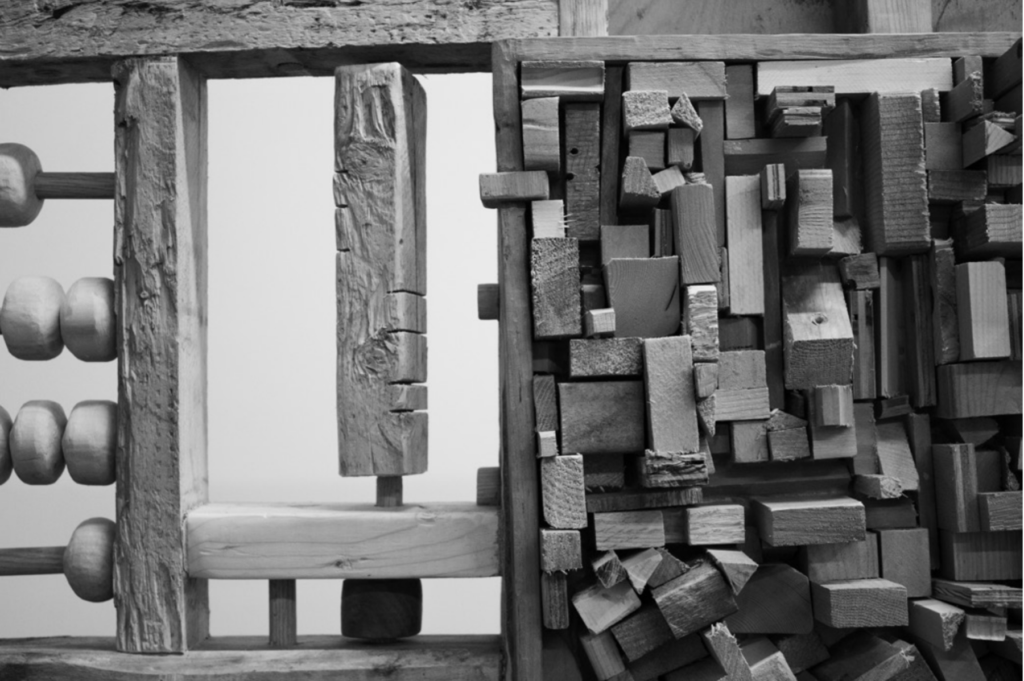James Maurelle: Palm
Review by Sheila Dickinson
The Bindery Projects
Mar 26–May 1, 2016

It’s so refreshing to walk into a gallery and see the space filled with pure abstraction, yet still be able to feel one’s way through the exhibition. I do not mean to feel literally with my hands, but the concept of Palm clearly ask the viewer to think about touching and feeling. James Maurelle returns to work with his hands as he did as a child apprentice to his grandfather plumber and father architect in this most recent work. The one large gallery at The Bindery Projects is filled with raw wood, rarely carved, more assembled in sculptural wall hangings and few standalone pieces. A brief, recent video work, I AM – I AM, asks, who are you?, from an adjacent room.
I was immediately drawn to a triptych hanging on a far wall, perhaps because of the recognizable forms, old wooden letter press boxes hung vertically in a row, old shallow rectangular boxes filled with small compartments to hold letters. In IS one, two, three, Maurelle fills the small slots with bits of odd sized wood pieces. A small stack of leftover wood blocks rest on top of one the boxes, giving the sense that they are interchangeable, that they don’t need to remain stuck in one place.
The desire to pick up a spare piece and see if it fits better into one of the compartments than another overwhelms me, wanting to get lost in the endless shuffling around of pieces. I think of a child in a woodworking shop picking up the stray wood ends and making a game, remembering Maurelle’s family lineage of plumbers and architects. These odd sized discarded wood remnants appear in most of his art in the gallery, creating an aesthetic texture. The textural qualities are heightened by the fact that each piece can fit into the palm of the hand. The pause lingers in the work, knowing that each piece is held while the artist considers, where will this one fit? Thoughtfulness and care lend gravitas to the artwork that at first glance looks arbitrary and haphazard. A compelling combination.
Wedged between the letter press compartments in IS one, two, three are several flat wood panels with raised wooden dots spaced in a braille-like form. My hand craves to touch, to know without looking, to think through feeling. Because blindness knows no difference, at least blindness offers a completely other criteria for judging people. Joanna Zylinska writes, “The ethics of blindness does not denigrate sight as opposed to the other senses, but rather creatively explores the crevices and gaps resulting from the imperfection of representation.”1
Maurelle’s dependence on abstraction speaks to the “imperfection of representation” that blindness brings to mind. No wonder that Ouidanaja, a large rectangular free standing wood sculpture, invites and allows the viewer to touch. Hesitant at first, viewers seem to gravitate and linger around this piece, sliding the abacus like beads along the spindle, turning square blocks and opening an odd little empty drawer.
Who are you? keeps calling from the I AM – I AM soundtrack in the nearby video room. Upbeat and happy found clips from 1970’s kids programming of two boys, one black, one Latino, saying their names anchor the video. Keeping with the theme of Palm, Leon plays bongo drums after he says his name and Luiz does a hand waving dance in his bell bottoms. In the space between these boys the film interchanges pictures of racially diverse children at a dizzyingly fast speed.
As I left the video screening room, suddenly the two spherical wood sculptures on top of pedestals morphed into portraits. Entirely abstract with no facial representation, the heads carry a fragmented sense of identity with glued bits of wood not fitting together at all. With the satiating phrase of “Who are you?” still playing behind me it seems that Maurelle is saying we have only a limited choice. We are given as children nuggets of information and lessons from our surroundings – family, society and school – to put together in some way or another, but we are given only what we are given. We do not seek out and choose these things our families give us. One may stray and attempt to be new and original, but we only know what we have been exposed to, what has been provided for us by genealogy, by gender, by race, by what might feel in the 21st Century as moveable pieces, but the pieces are that indispensable core.
Ouidanaja, with its aging educational tools – abacus beads and an embedded green chalkboard – looks like a two sided relief sculpture rather than a three dimensional form. Jutting out from a segment of the piece are the jagged cut edges of the leftover wood bits, remarking on how the parent gives the child these small wooden nuggets and says, “Here, put them together in the best way you can.” This work considers the exchange of teaching and learning on both sides of the transactional exchange as child and as parent, mediating between generations. Maurelle also brings this conundrum to bear upon artistic heritages and lineages that are foreign and familiar, respected and mocked.
Take Walking on My Hands, a framed wall piece with a “canvas” made of raw wood. It could only have been made while it lay on the floor covered in glue, while detritus from a woodshop floor, sawdust clumps, wood shavings, adhere to the surface. Two geometric shapes remain pristine and untouched by the mess. Here, Maurelle brings in the concept of chance, letting the things fall where they may. A palette of disregard, carelessness, and defiance that celebrates abstraction but challenges a viability of individual expression. Rather than Pollock, his work links more directly to Arte Povera and the insistence on not letting anything go to waste.
